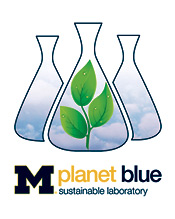
As one the world’s leading research institutions, U-M has hundreds of laboratories on the Ann Arbor campus that serve as an integral part of the institution’s research efforts.
But these laboratories also are among the largest generators of regulated wastes on campus, and they consume significant amounts of energy and resources.
To help laboratory managers operate these vital facilities in the most efficient and sustainable manner, the Office of Campus Sustainability (OCS) launched the Green Laboratory Operation for Sustainability program, which already has an impressive list of laboratories that have been certified under the program.
“The average laboratory consumes four to five times more energy and resources as compared to a classroom or an office environment, and they may generate large volumes of hazardous waste and consume large quantities of water as well,” says Sudhakar Reddy, sustainable chemistry coordinator for OCS and lead on the sustainable laboratory program. “We have a real opportunity here at U-M to save energy and resources through this program.”
The program is run in a phased manner to lessen the impact on laboratory staff resources. Once a laboratory manager contacts OCS, the OCS staff visits the laboratory to evaluate its current practices in areas such as pollution prevention, waste minimization, green purchasing, recycling, green chemistry, chemical treatment and disposal.
Following the evaluation, specific recommendations for the particular laboratory are provided along with suggestions to the laboratory staff on how to best implement them. After the recommendations are implemented, a follow-up visit is conducted at which time the laboratory is formally recognized as a U-M Sustainable Laboratory.
To date, 10 laboratories on campus have received certification ranging from platinum — the highest level of certification — to silver. The laboratories are:
• Cytopathology Laboratory, U-M Health System — platinum
• Immunology Laboratory, A. Alfred Taubman Biomedical Science Research Building, Medical School — platinum
• Histocompatibility Laboratory, Traverwood II, UMHS — platinum
• Anesthesiology Laboratory Medical Science Building I — gold
• Chinnaiyan Laboratory, Comprehensive Cancer Center — gold
• Lurie Nanofabrication Facility Laboratory, Lurie Biomedical Engineering Buildings — gold
• Mueller Laboratory, College of Pharmacy — gold
• Savage Laboratory, College of Engineering — gold
• Undergraduate Student Building Teaching Laboratory, LSA — silver
• Maldonado Laboratory, Chemistry, LSA — silver
Laboratory managers are seeing real benefits from this program, including the introduction to green chemistry practices, reduced consumption of energy and utilities, reduction in the use and generation of hazardous materials, increased recycling, and improved safety for laboratory students, faculty and staff.
“Our new sustainable lab practices have resulted in savings of chemicals and supplies,” says Pilar Herrera-Fierro, lead research engineer at the Lurie Nanofabrication Facility and a CoE faculty member. “The LNF community, users and staff have embraced sustainable lab practices wholeheartedly.”
To learn more about the Green Laboratory Operation for Sustainability, go to www.ocs.umich.edu/labs.shtml. U-M laboratory managers interested in participating in the program can contact Reddy at 734-763-4615, or by email [email protected].

